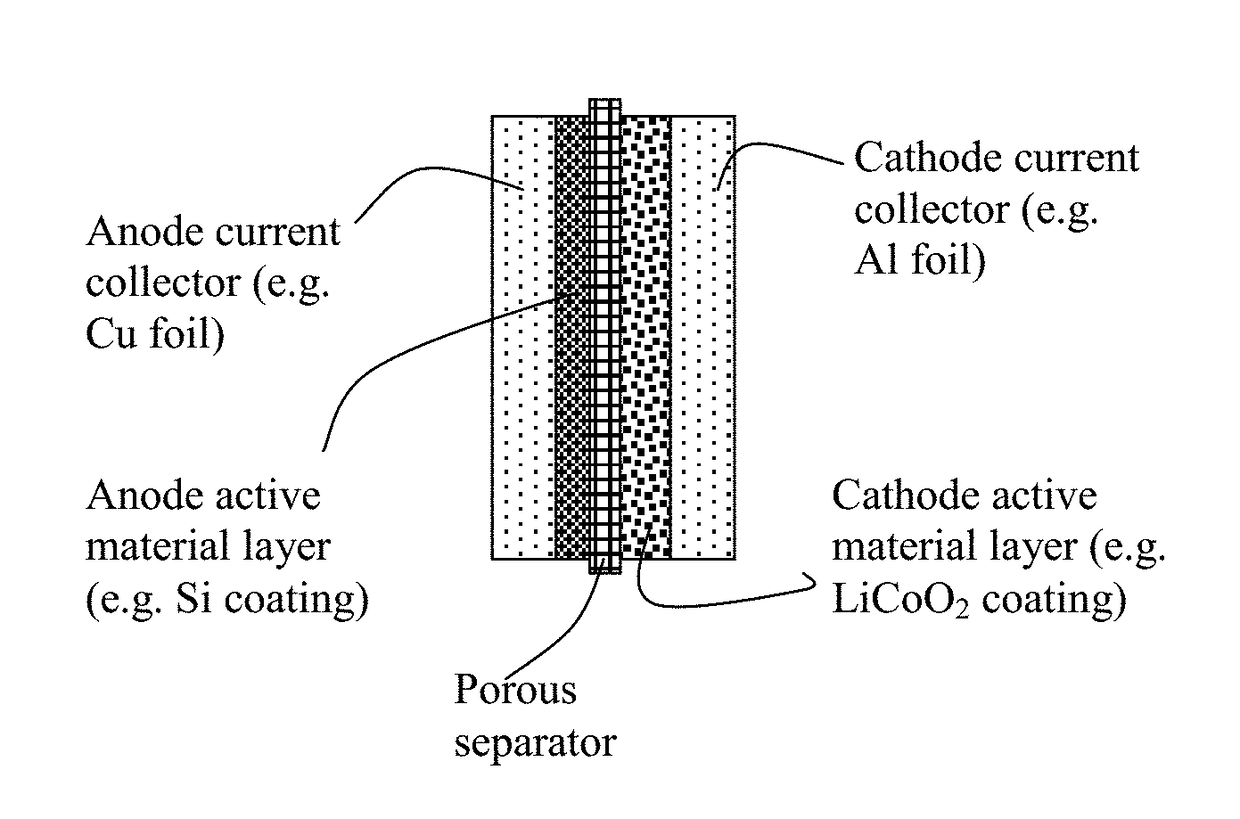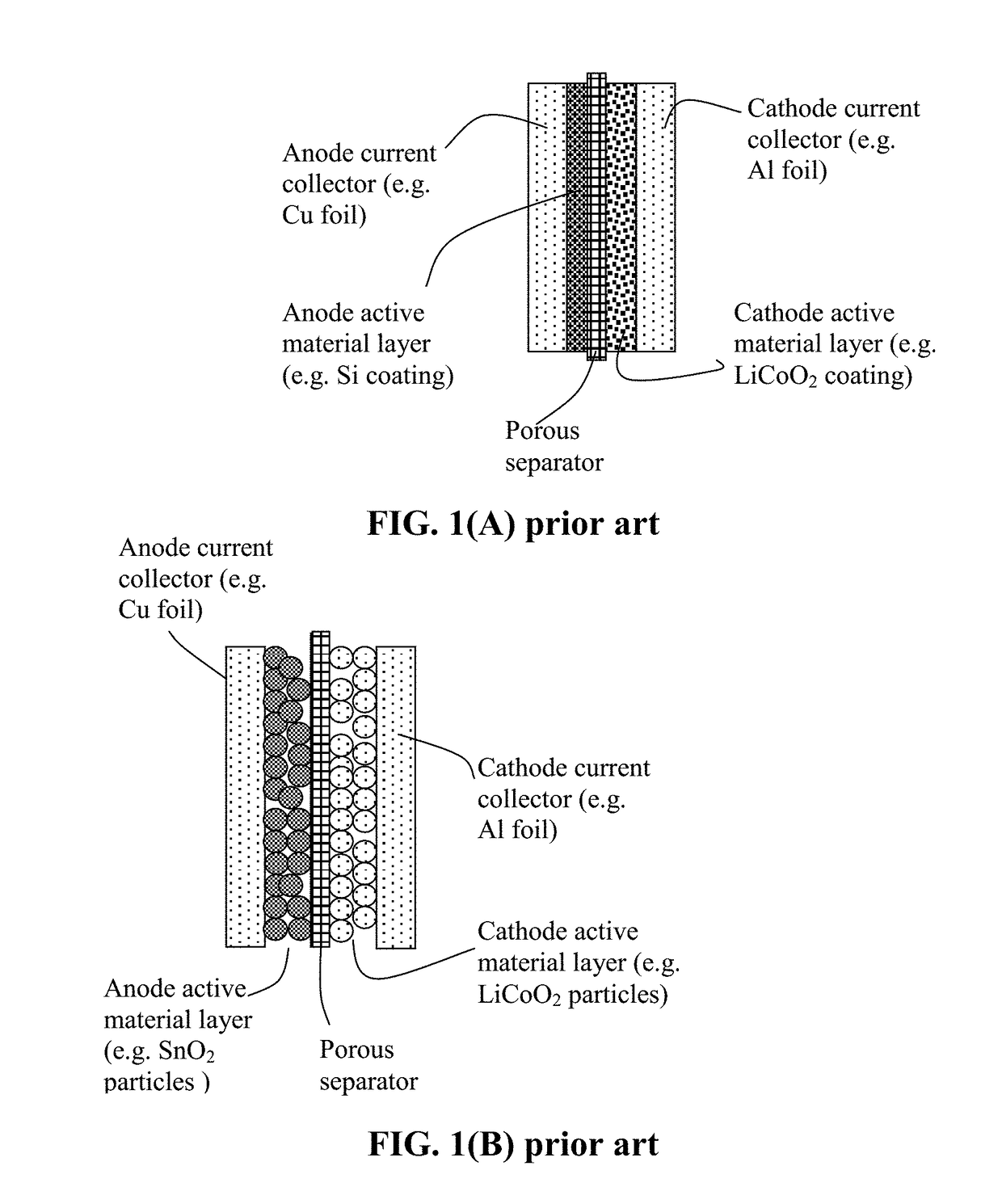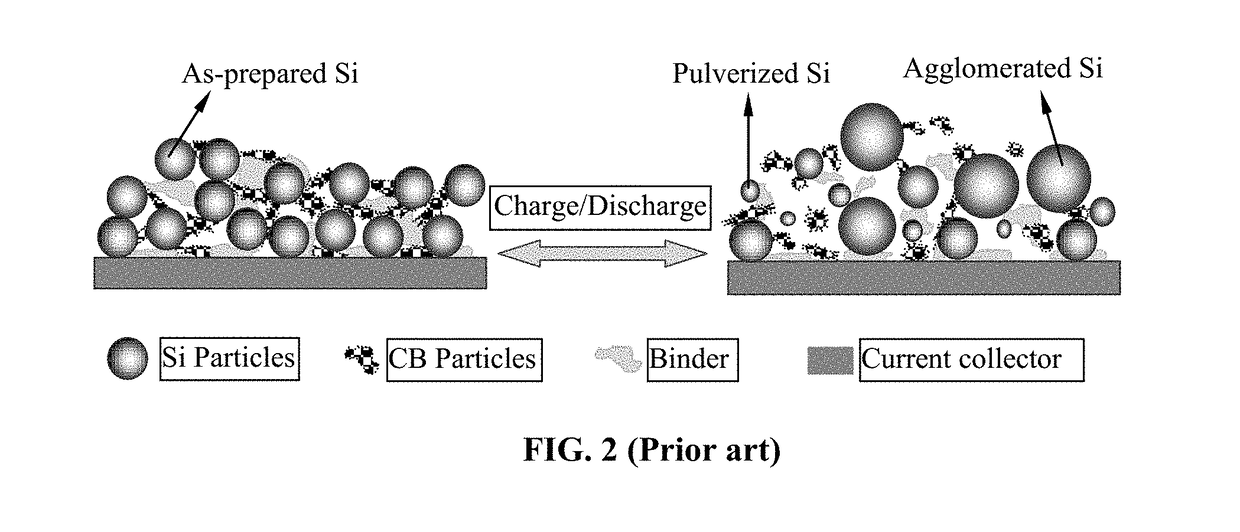Polymer Binder for Lithium Battery and Method of Manufacturing
a lithium battery and polymer technology, applied in the field of rechargeable lithium batteries, can solve the problems of loss of contacts between active materials and conductive additives, severe pulverization and detachment loss of active materials from resin binders, etc., to achieve the effect of improving lithium ion conductivity to a polymer
- Summary
- Abstract
- Description
- Claims
- Application Information
AI Technical Summary
Benefits of technology
Problems solved by technology
Method used
Image
Examples
example 2
ticity Polymer Binder-Bonded Tin Oxide Particulates
[0104]Tin oxide (SnO2) nano particles were obtained by the controlled hydrolysis of SnCl4.5H2O with NaOH using the following procedure: SnCl4.5H2O (0.95 g, 2.7 m-mol) and NaOH (0.212 g, 5.3 m-mol) were dissolved in 50 mL of distilled water each. The NaOH solution was added drop-wise under vigorous stirring to the tin chloride solution at a rate of 1 mL / min. This solution was homogenized by sonication for 5 min. Subsequently, the resulting hydrosol was reacted with H2SO4. To this mixed solution, few drops of 0.1 M of H2SO4 were added to flocculate the product. The precipitated solid was collected by centrifugation, washed with water and ethanol, and dried in vacuum. The dried product was heat-treated at 400° C. for 2 h under Ar atmosphere.
[0105]The high-elasticity polymer for binding SnO2 nano particles was based on cationic polymerization and cross-linking of the cyanoethyl polyvinyl alcohol (PVA-CN) in succinonitrile (SN). The proc...
example 3
Nano Particles Bonded by a PETEA-Based High-Elasticity Polymer
[0108]For serving as a resin binder to bond Sn nano particles together, pentaerythritol tetraacrylate (PETEA), Formula 3, was used as a monomer:
[0109]The precursor solution was composed of 1.5 wt. % PETEA (C17H20O8) monomer and 0.1 wt. % azodiisobutyronitrile (AIBN, C8H12N4) initiator dissolved in a solvent mixture of 1,2-dioxolane (DOL) / dimethoxymethane (DME)(1:1 by volume). Nano particles (76 nm in diameter) of Sn were added into the precursor solution, which was coated onto a Cu foil. The PETEA / AIBN precursor solution was polymerized and cured at 70° C. for half an hour to obtain an anode layer.
[0110]The reacting mass, PETEA / AIBN (without Sn particles), was cast onto a glass surface to form several films which were polymerized and cured to obtain cross-linked polymers having different degrees of cross-linking. Tensile testing was also conducted on these films and some testing results are summarized in FIG. 5(A). This s...
example 4
re-Based Particulates Protected by a High-Elasticity Polymer
[0113]Si nano particles and Si nanowires Si nano particles are available from Angstron Energy Co. (Dayton, Ohio). Si nanowires, mixtures of Si and carbon, and their graphene sheets-embraced versions, respectively, were mixed with particles of acetylene black (a conductive additive) and formed into an active material layer using the instant polymers as a binder resin (semi-interpenetrating network polymer of ETPTA / EGMEA and the cross-linked BPO / ETPTA polymer, as in Example 1).
[0114]For bonding various anode particles together by the ETPTA semi-IPN polymer, the ETPTA (Mw=428 g / mol, trivalent acrylate monomer), EGMEA (Mw=482 g / mol, monovalent acrylate oligomer), and 2-hydroxy-2-methyl-1-phenyl-1-propanone (HMPP, a photoinitiator) were dissolved in a solvent (propylene carbonate, PC) to form a solution. The weight ratio between HMPP and the ETPTA / EGMEA mixture was varied from 0.2% to 2%. The ETPTA / EGMEA proportion in the soluti...
PUM
| Property | Measurement | Unit |
|---|---|---|
| lithium ion conductivity | aaaaa | aaaaa |
| tensile strain | aaaaa | aaaaa |
| diameter | aaaaa | aaaaa |
Abstract
Description
Claims
Application Information
 Login to View More
Login to View More - R&D
- Intellectual Property
- Life Sciences
- Materials
- Tech Scout
- Unparalleled Data Quality
- Higher Quality Content
- 60% Fewer Hallucinations
Browse by: Latest US Patents, China's latest patents, Technical Efficacy Thesaurus, Application Domain, Technology Topic, Popular Technical Reports.
© 2025 PatSnap. All rights reserved.Legal|Privacy policy|Modern Slavery Act Transparency Statement|Sitemap|About US| Contact US: help@patsnap.com



